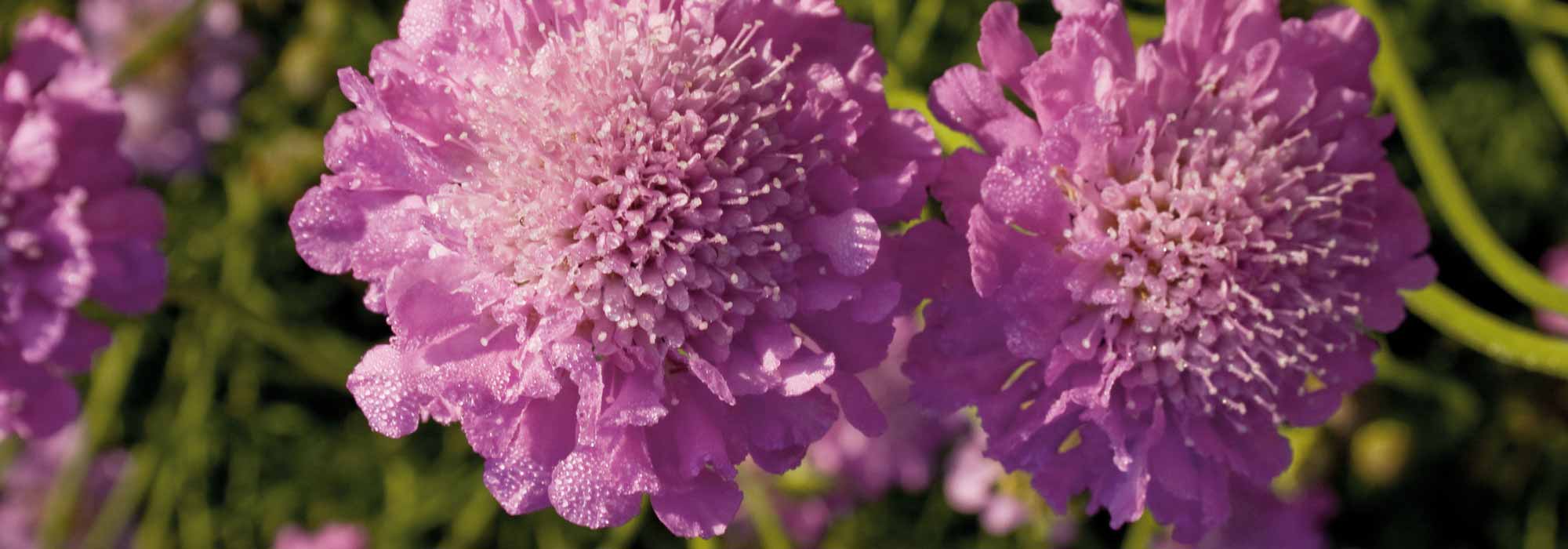
Scabiosa: sowing, planting and growing
Contents
Scabious in a nutshell
- Scabious offers a wonderfully simple and uniquely beautiful flowering that lasts from spring to autumn without interruption
- It is appreciated for its soft blue or white colours and its tendency to flower profusely
- It is one of the easiest plants to grow, in any well-drained soil
- Hardy, it possesses the robustness of wild plants
- It is the ideal perennial for naturalistic beds, contemporary meadow gardens, borders, or country-style bouquets
A word from our expert
Although very old, Scabious remains an unjustly overlooked flower. Queen of the gardens of yesteryear, familiar in cottage gardens, this flower with its unique beauty, neglected in recent years, is making a strong comeback in all country or slightly wild gardens, bringing breath and lightness to them. An excellent cut flower, it is also perfect for a cottage garden.
The scabious is a melliferous, perennial or annual herbaceous plant, appreciated for its airy and generous flowering that blooms all summer long, attracting bees and many other pollinators.
With its wildflower appearance, it has the accommodating character and hardiness of wild plants that grow freely in meadows and along roadsides.
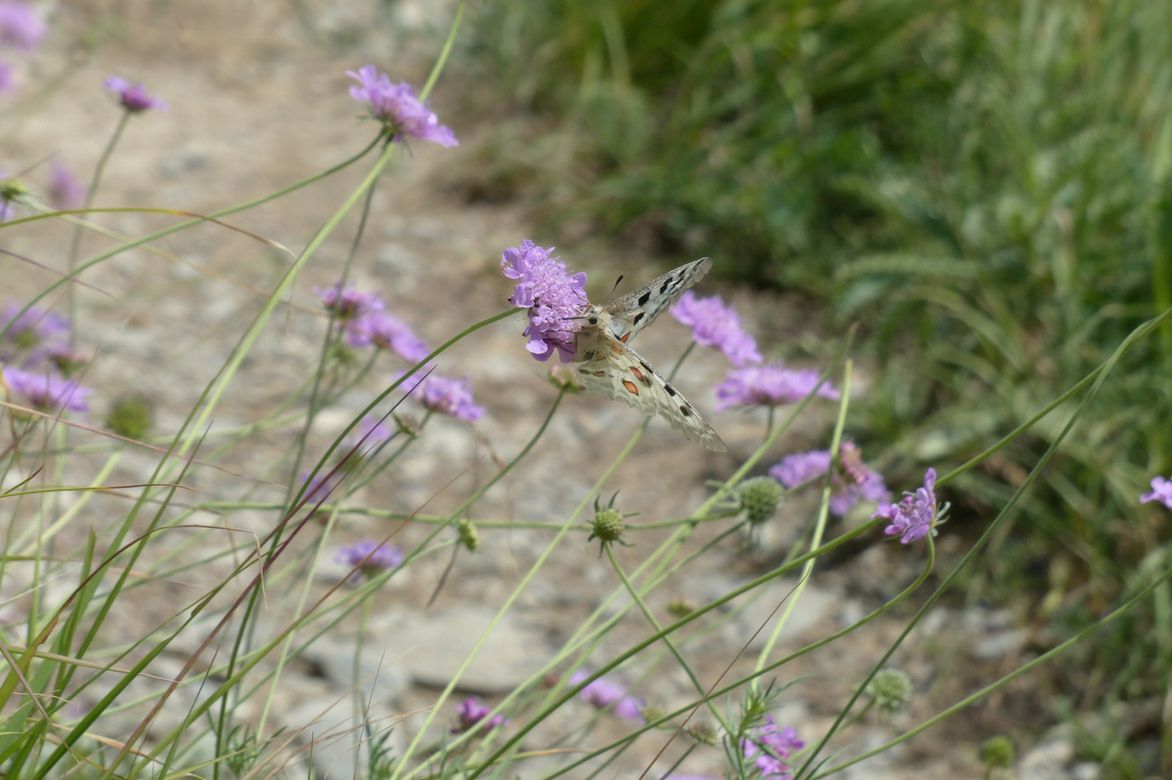
Scabious, flowers resembling wildflowers.
The Scabious adorns itself with pastel or purple shades of delicate refinement, enchanting summer gardens as well as bouquets.
Purple scabious like the variety ‘Chile Black’, white scabious, blue scabious, or pink scabious, from Caucasian Scabious to Columbine Scabious, whether perennial or annual, tall or dwarf, all combine simple grace with great ease of cultivation.
It is a beautiful, docile, and hardy summer flower, easy to grow in any sunny garden in ordinary, well-drained soil. It allows for the quick creation of a colourful country decor.
Discover in our collection of scabious and our scabious seeds, the variety that is missing from your perennial beds, rockeries, or borders and from your summer bouquets!
Description and Botany
Botanical data
- Latin name Scabiosa
- Family Dipsacaceae
- Common name Scabious
- Flowering from May to autumn
- Height 0.20 to 1 m
- Exposure Sun
- Soil type All, well-drained
- Hardiness -15°C
Scabious is a herbaceous plant from the family Dipsacaceae, much like Knautia, to which it bears a strong resemblance. The genus Scabiosa comprises around 80 species of annuals, biennials, or predominantly perennials, native to the meadows and rocky slopes of Mediterranean regions, Europe, particularly the Caucasus, as well as Africa and Asia.
There are numerous varieties within the genus, divided between annual and perennial species. In our gardens, we encounter the very popular Caucasian scabious (S. caucasica), which has many cultivars (‘Perfecta’, ‘Alba’) in white and blue, the small scabious (S. columbaria) that grows wild in mountain meadows and its cultivars (‘Pink Mist’, ‘Butterfly Blue’) recognizable by its finely dissected silver-grey foliage, Scabiosa graminifolia with very fine greyish foliage resembling that of grasses, Scabiosa ochroleuca with lemon-yellow flowers, and the garden scabious (Scabiosa atropurpurea), also known as “dark purple scabious” and its famous cultivar ‘Chile Black’, which is sometimes perennial in mild climates but most often grown as a biennial or annual. The starry scabious (Scabiosa stellata) is an annual species that produces original fruits that are particularly decorative.
Its bushy habit is somewhat loose, enhancing the elegance of the flowering. It has a silhouette that is both discreet and graceful, forming a beautiful upright tuft that is highly branched and robust, growing more or less tall, between 20 cm and 1 m, depending on the species and varieties.
Although it has a rapid growth, the scabious needs about two years to establish well, regrowing each year from the crown. The scabious develops quickly from a deep and extensive root system. Some perennial varieties have a short lifespan and sometimes behave like annuals, but all self-seed abundantly; this does not make them an unwanted invader!
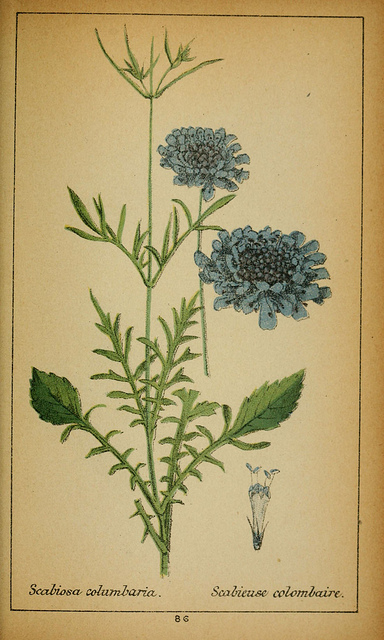
Scabiosa columbaria – botanical illustration
From a basal rosette of leaves, long more or less branched stems emerge in spring, pubescent, thin but robust.
The deciduous to semi-evergreen foliage is mainly basal and arises from the hollow of the plant’s collar. It consists of simple, entire, or lobed leaves, sometimes slightly or coarsely dentate. The leaves, 3 to 15 cm long, oblong, ovate, or lanceolate and arranged oppositely, are more or less villous.
Finely dissected in the garden scabious and the small scabious, they are persistent, very fine, and silvery, resembling those of grasses in the grass-leaved scabious (S. graminifolia). Their hues range from bright green to bluish-grey or silvery.
As one moves up the stem, the leaves become fewer until reaching the head.
The scabious has a light and generous flowering that lasts throughout the beautiful season until the first frosts.
From May to October, the inflorescences in fragrant heads composed or solitary, measuring 2 to 8 cm in diameter, sway in the wind at the end of the numerous stems, each bearing only a single flower head.
The scabious flower resembles a wildflower and is a marvel of simplicity and delicacy. Its shape varies according to the species: these beautiful long-stemmed heads can appear flattened, evoking a jewel set with small pearls, or more globose, dense, and hirsute, resembling a light pom-pom.
In this case, the small flowers are spotted with prominent stamens that resemble a miniature pin cushion, giving the plant (Scabiosa atropurpurea, Scabiosa columbaria, Scabiosa graminifolia, Scabiosa ochroleuca) a delightfully tousled appearance, earning it the nickname “Pincushion Flower” across the Channel, meaning “head of pins.”
The Caucasian scabious is distinguished by its large flat heads with a slightly domed centre.
 Several flower colours: Scabiosa caucasica ‘Perfecta’, Scabiosa caucasica ‘Alba’, Scabiosa columbaria ‘Pink Mist’, Scabiosa atropurpurea ‘Chile Black’.
Several flower colours: Scabiosa caucasica ‘Perfecta’, Scabiosa caucasica ‘Alba’, Scabiosa columbaria ‘Pink Mist’, Scabiosa atropurpurea ‘Chile Black’.
The heads are formed of tightly packed florets surrounded by wrinkled and serrated petals with a crumpled appearance.
While the scabious flower most often comes in various shades of blue, lavender, lilac, and mauve, there are also varieties in cream, white, or even yellow (Scabiosa ochroleuca). The Scabiosa atropurpurea or garden scabious offers dark double flowers, well-rounded and fragrant, displaying a reddish-purple-chocolate almost black hue speckled with white stamens that contrast with beautiful bright green foliage.
In some forms, the petals are sometimes paler around the edges, darkening towards the centre, just illuminated by a quantity of white stamens.
This remarkably abundant melliferous flowering lasts about 4 months: the flowers renew themselves continuously throughout the summer until autumn within the beds, attracting numerous pollinating insects, bees, butterflies, and other foragers.
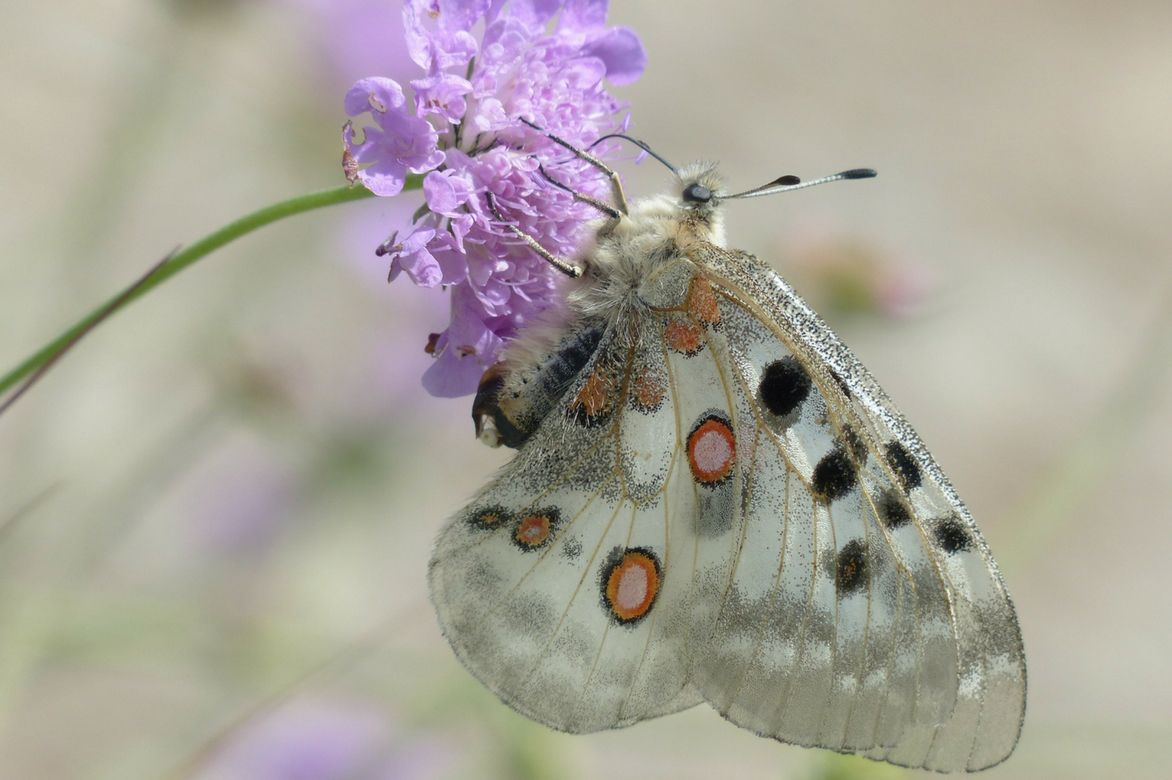 Scabious are melliferous flowers.
Scabious are melliferous flowers.
Some species (purple scabious) emit a delightful honey scent.
The scabious is well-suited for creating airy wildflower bouquets, fresh throughout the summer, lasting 10 days in a vase or dried in autumn.
After fading, the flowers transform into spherical fruits that are more or less original and developed depending on the species into pin cushions or “fluffy pin balls”; in the starry scabious, these are silver capsules forming a striking alveolate globe of tightly packed bracts with a green heart striped with brown, particularly graphic in dry bouquets.
 Evolution of a flower of small scabious.
Evolution of a flower of small scabious.
The scabious has retained from its mountainous origins its accommodating character and the robustness of wild plants that grow alone without maintenance, on dry banks and roadside edges. Very hardy, sometimes beyond -15°C, it can be cultivated in all regions.
It is one of the easiest plants to grow, in the sun, in all well-drained garden soils, slightly calcareous. It brings a rustic touch to naturalist gardens, mixed borders, or in summer flower beds.
The scabious derives its name from the Latin “scabies” meaning “scab”, as due to the medicinal properties concentrated in its root and leaves, it was used to treat this ailment. It also has the reputation of being the flower of mourning, and for its undemanding nature in tolerating harsh soils, it is also called widow’s flower.
Read also
Centaury: sowing, planting and careMain species and varieties
Scabious plants are numerous. We distinguish between perennial scabious such as the very popular Caucasian Scabious (S.caucasica) with its many cultivars (‘Alba’, ‘Fama’) that come in different shades of white and blue, the small pompon-like flowers of the blue-violet or pink columbine scabious (S. columbaria) (‘Butterfly Blue’, ‘Pink Mist’), and the less perennial scabious like the garden scabious (Scabiosa atropurpurea), which is very interesting for its purple colour, often grown as a biennial or an annual.
This beautiful summer plant, somewhat neglected in recent years, is making a comeback in our gardens, with extraordinary colours such as the purple-black varieties like ‘Chile Black’ or ‘Black Knight’.
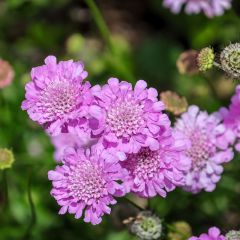
Scabiosa columbaria Pink Mist
- Flowering time July to October
- Height at maturity 40 cm
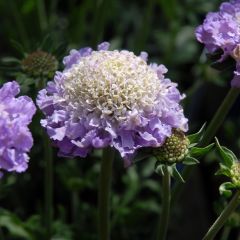
Scabiosa columbaria Butterfly Blue
- Flowering time July to October
- Height at maturity 40 cm
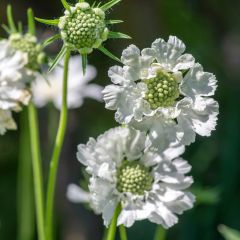
Scabiosa caucasica Alba
- Flowering time July to October
- Height at maturity 50 cm

Scabiosa atropurpurea Black Knight Seeds
- Flowering time August to November
- Height at maturity 70 cm
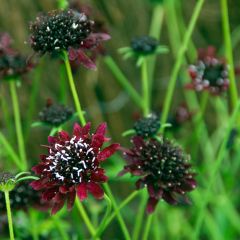
Scabiosa atropurpurea Chile Black
- Flowering time July to October
- Height at maturity 50 cm
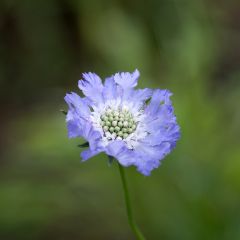
Scabiosa caucasica Perfecta
- Flowering time July to October
- Height at maturity 50 cm

Scabiosa Beaujolais Bonnets
- Flowering time July to October
- Height at maturity 50 cm
Discover other Scabiosa - Pincushion
View all →Available in 0 sizes
Available in 2 sizes
Available in 0 sizes
Available in 2 sizes
Available in 1 sizes
Available in 2 sizes
Available in 1 sizes
Available in 1 sizes
Available in 1 sizes
Available in 1 sizes
Young plantation
Where to Plant Scabious?
Very easy to grow, with a good hardiness down to -15°C, Scabious thrives all over France. Originating from mountainous regions, it is found in temperate Europe up to 2,000 metres in altitude. It has retained a low-maintenance character and is capable of growing on its own, without care, on dry slopes and along paths.
Scabious prefers light, well-drained soils and even tolerates those with a tendency towards lime. It accepts any good garden soil that is sufficiently drained as long as it is fairly cool, but neither heavy nor waterlogged. Winter flooding is fatal for it: it needs a very well-draining soil.
However, long-lived varieties will thrive best in a soil rich in organic matter.
In terms of exposure, plant scabious in a warm, sunny position in the north and a little more shaded in the south. It is a robust plant that holds up well even in windy conditions.
Although over time, scabious can withstand short periods of drought, it will appreciate having its roots kept cool under a good mulch during summer, especially in the first few years.
Once well-rooted, the perennial scabious will thrive year after year, eventually forming dense, highly floriferous clumps: give it some space! Some perennial scabious, like the Garden Scabious, are, however, less enduring and have a shorter life cycle, potentially turning out to be annuals.
It fills empty spaces in record time and allows for the quick creation of a rustic, airy, and colourful display.
Scabious is perfect everywhere: in natural gardens with flowering meadows, rockeries, in rustic pots, along paths or fences, to dress a path, in perennial borders with a wild appearance to which they add a lot of lightness. The tallest varieties with large crumpled flowers will structure the mixed borders.
Sowing scabious is valuable in orchards, vegetable gardens and near fruit trees in the garden, as they are very melliferous and attract many pollinating insects.
When to Sow Scabious?
Scabious seeds can be sown under cover in trays from March to protect them from the last frosts. You can also sow Scabious directly in the ground from April to the end of May depending on the regions, as soon as the soil is warmed up.
How to Sow Scabious?
Under Cover
This is one of the easiest sowings to succeed!
- In March, at a temperature of 18-20 °C, sow thinly in trays a few scabious seeds in a light mixture of peat (70%) and sand (30%)
- Do not bury the seeds more than 1 cm deep and cover with a thin layer of potting soil
- Press down and water gently
- Keep slightly moist in the sun until germination in about two weeks
- As soon as the seedlings are strong enough, place them in individual buckets
- Allow the surface to dry between waterings
- Transplant in May into the ground as soon as the risk of frost has passed or into pots or containers in a substrate enriched with compost
In the Ground
- In May, sow scabious seeds broadcast in well-loosened soil amended with potting soil and lightened with coarse sand
- Cover with a thin layer of potting soil
- Press down
- Water and keep the soil moist until germination
- Thin out the seedlings to leave 15 to 40 cm between plants
How to Plant Scabious?
In the Ground
Scabious benefits from being planted in small groups of 5 to 7 plants per m² for a beautiful airy effect. Plant the buckets in spring when the risk of frost is over, in April-May or September-October. Space the plants according to the species and varieties; from 15 to 30 cm for the low species, and from 40 to 50 cm for the taller scabious.
- Prepare the soil
- Dig a hole three times wider than the root ball
- Add a little river sand or gravel to improve drainage, possibly a bit of potting soil
- Plant without burying the collar of the plant
- Backfill with the extracted soil mixed with compost
- Press down with your hand or foot
- Mulch and water generously
- Protect young plants from snails and slugs
In a Pot
- Plant scabious in a large 30 cm diameter pot in a mixture of potting soil and compost
- Spread a good layer of drainage (gravel or clay balls) at the bottom of the pot for good drainage
- Mulch and water regularly
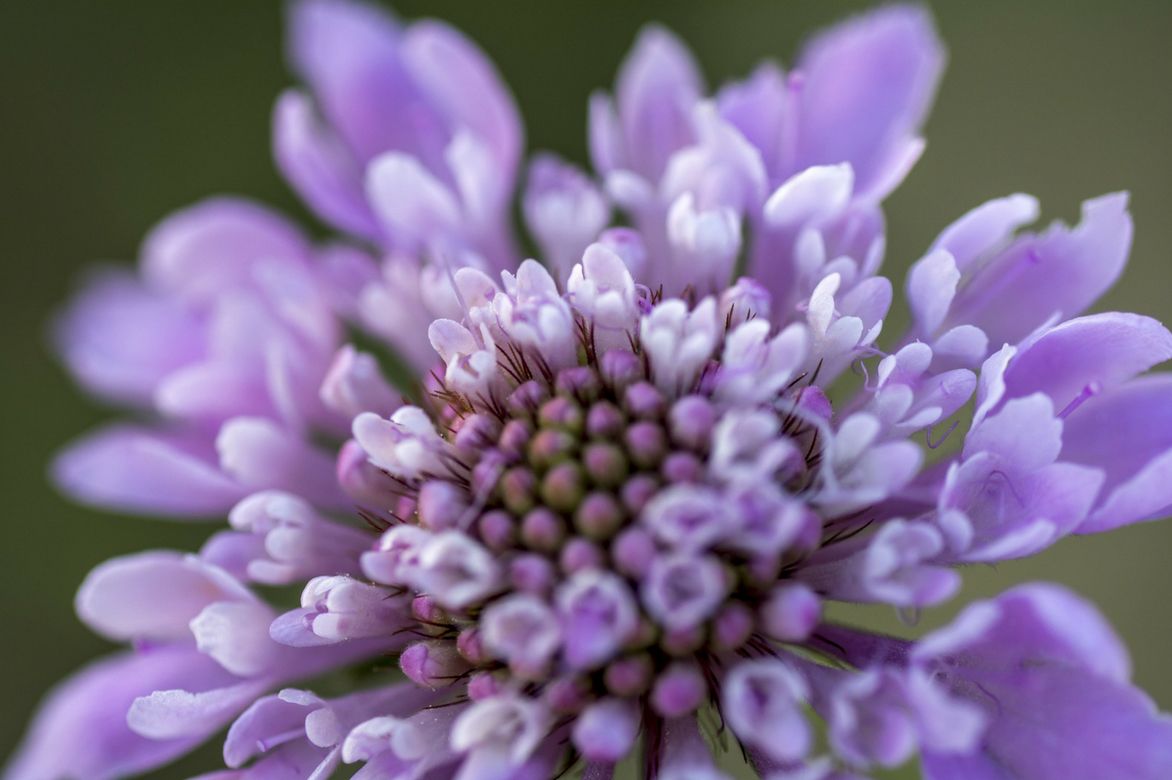
Close-up of scabious flower.
Read also
Sowing seeds directly in the groundMaintenance, pruning and care
The Scabious is a truly low-maintenance perennial: ideal for weekend gardens or those without gardeners!
Once well established, it requires little care as long as the soil remains perfectly drained and fairly cool in summer.
During the first springs and summers, provide it with regular watering but avoid overwatering. After that, regular but limited watering during the summer will suffice. Over time, it will withstand short periods of drought.
Mulch in May to ensure the base remains sufficiently cool in summer.
Remove faded flowers regularly as they appear to prolong the flowering: take the opportunity to create bouquets!
To help them survive winter, protected from the cold and frost, mulch the base with dried leaves or straw.
Each spring, enrich the base with organic fertiliser to encourage flowering and keep it vigorous.
In autumn, cut back the clumps of perennial scabious to ground level to prevent invasive self-seeding (make dry bouquets).
They can sometimes decline after 3 or 4 seasons: divide the larger perennial clumps to rejuvenate them.
Diseases and potential pests
Never sick, the Scabious is rarely prone to diseases. In spring, protect its young shoots from the appetite of slugs and snails, using fern manure to combat their attacks.
Its main enemy? Heavy and wet soils in winter, where it can be susceptible to root and collar rot.
Multiplication
Annual scabious self-seed naturally in the garden. However, as the seeds are as fine as stardust, it is quite difficult to harvest them in autumn. Multiply it from our scabious seeds (follow the instructions above). Tuft division is easy with perennial scabious in spring or autumn after flowering.
Dividing Scabious Tufts
Tuft division should be done after 3 or 4 years, when the plant is well established.
- Using a spade, separate a few tufts
- Take the opportunity to rejuvenate the plant by keeping only the outer tufts and discarding the central clump
- Replant these tufts immediately in the garden in well-tilled, well-draining soil
Associate
The Scabious is particularly inspiring for creating a garden of naturalistic inspiration, or a mixed border in the spirit of cottage gardens with other easy-going upright perennials. Its rustic charm is inseparable from the vicarage gardens to which it brings a slightly cheeky lightness.
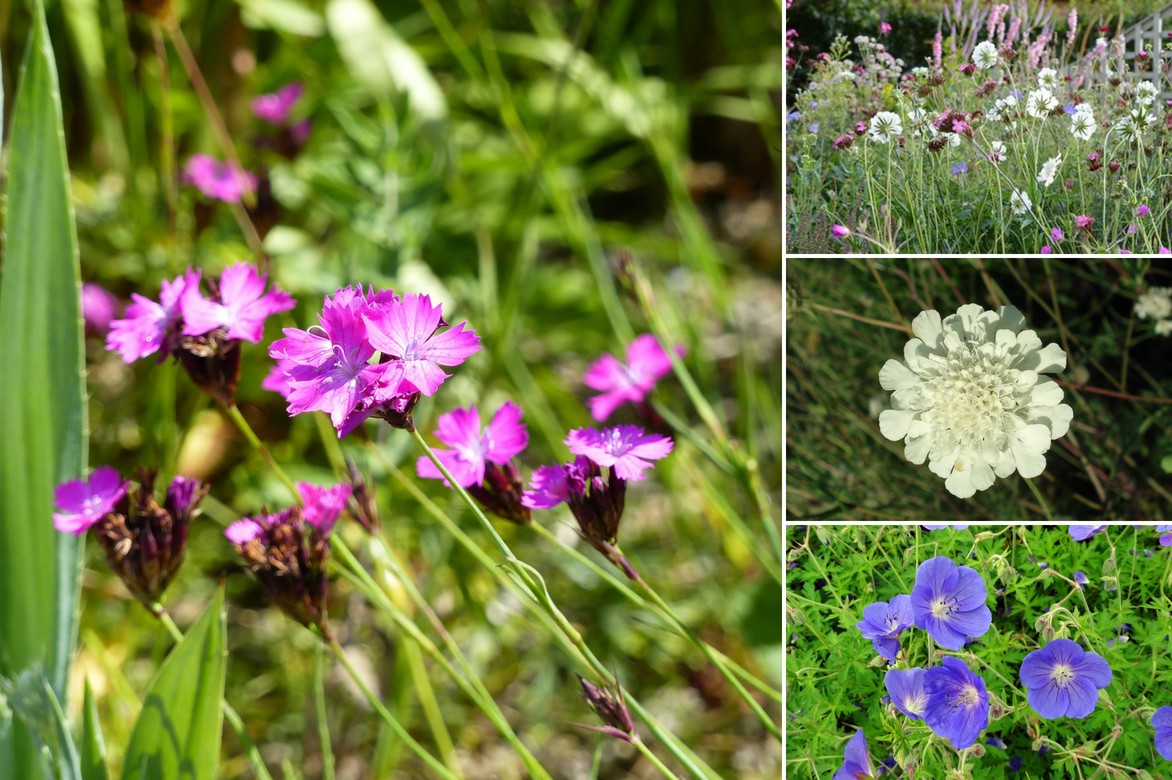
A rustic pairing idea: Scabiosa caucasica ‘Alba’, Dianthus carthusianorum, Geranium ‘Brookside’.
When planted in numbers, it provides contrast, either in pastel shades within mixes of cool mauve, purple, or white, or in more complementary associations of crimson/blue with salvias or the flowers of Dianthus deltoides.
With its naive appearance of a wildflower, it happily finds its place in naturalistic meadows and bountiful summer borders alongside carnations, perennial flax, phacelias, Damask nigellas, Penstemon, Cosmos, gauras, cornflowers, phlox, yarrow, and asters.
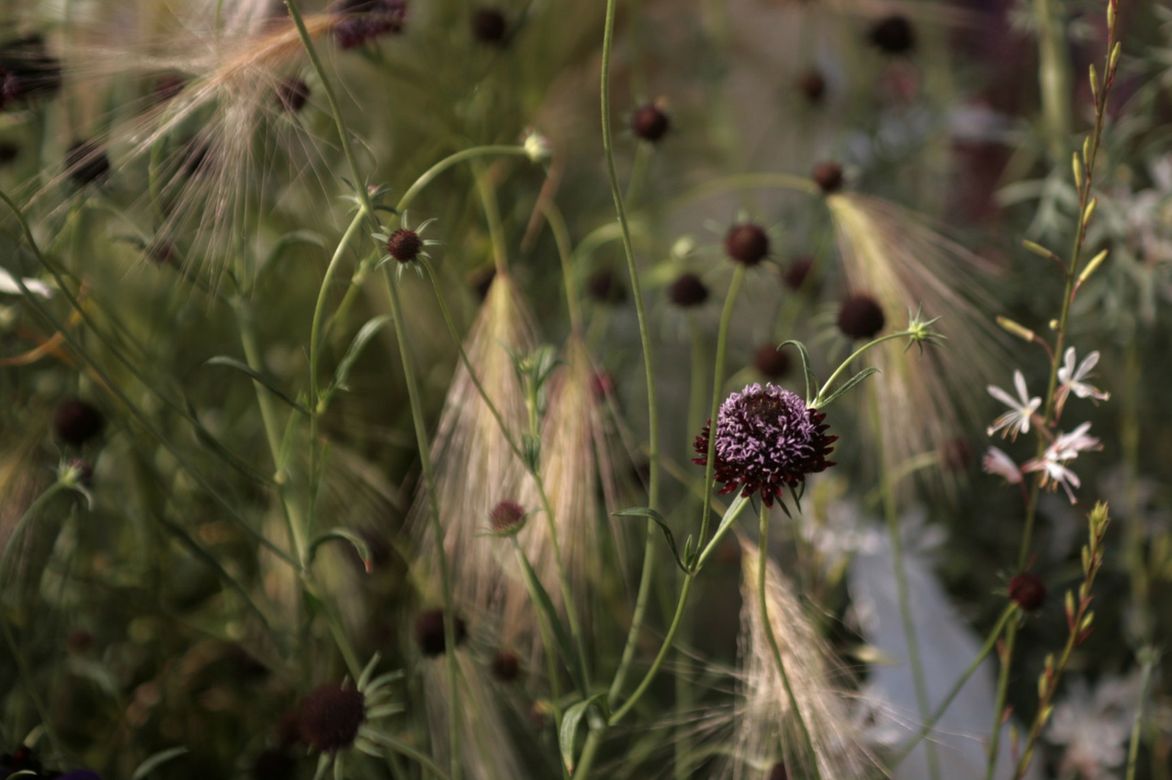
A natural pairing idea: Scabiosa ‘Chile Black’, Hordeum jubatum, Gaura lindheimeri.
To play with contrasts in shapes, dare to pair it with veronicas or even echinaceas, rudbeckias, and California poppies.
In a dry or very mineral garden, it will add a touch of pastel, scattered among grasses.
The large crumpled and structural flowers of Caucasian Scabious will easily find their place alongside Allium Cristophii with its large mauve umbels.
With its soft hues, it pairs well in a romantic border with low-growing roses, wormwoods, small blue thistles, hardy geraniums, peonies, or gypsophiles. It is also attractive alongside frost-tender perennials like white or pink anthemis.
A remarkable cut flower, scabious holds up well in a vase, mixed with perennial sweet peas, roses, and carnations.
→ Discover more pairing ideas with scabious in our advice sheet!
Useful resources
- Scabious is the queen of natural and naturalistic gardens!
- Scabious adds breath to your mixed border, adopt it!
- Accommodating, scabious is the ideal plant for gardens without gardeners, discover our tips for a low-maintenance garden
- Also discover Cephalaria, a giant scabious!
- Subscribe!
- Contents
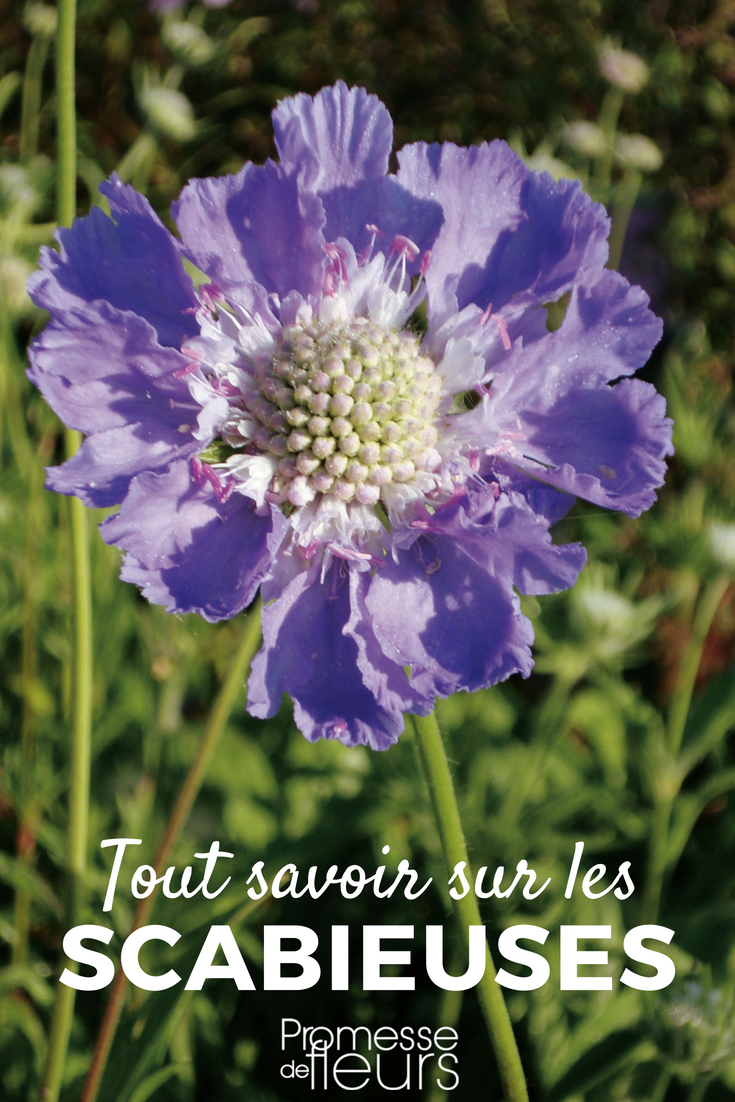































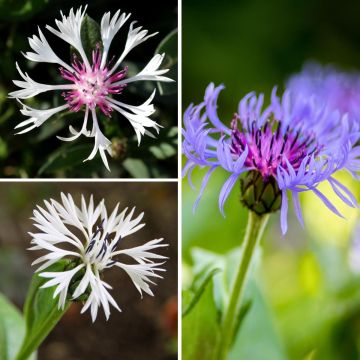





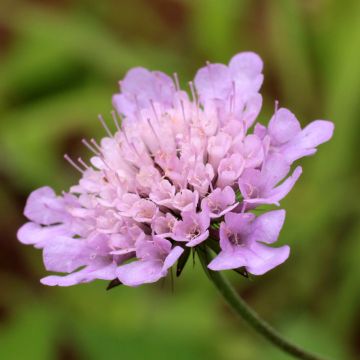
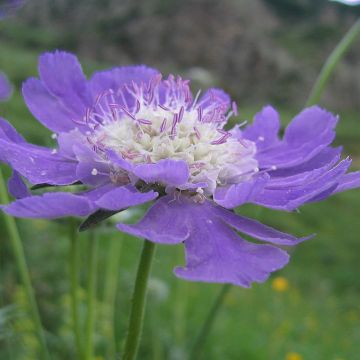
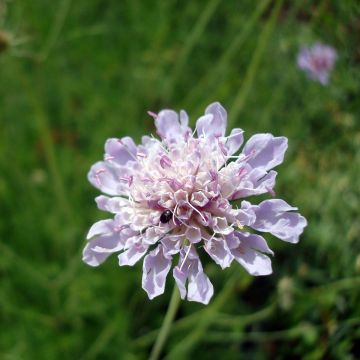
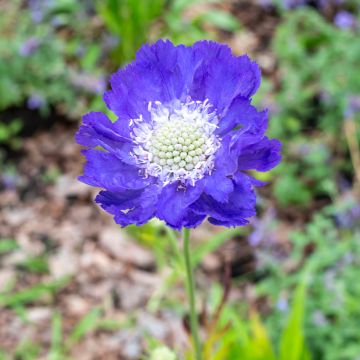
Comments